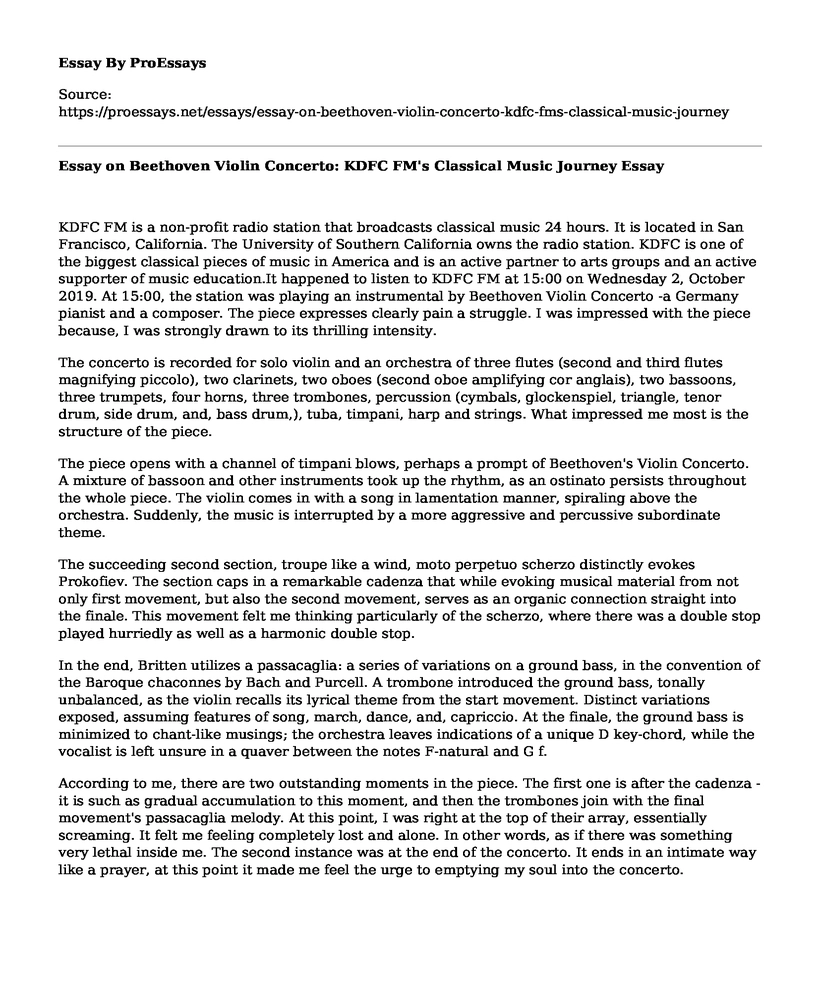KDFC FM is a non-profit radio station that broadcasts classical music 24 hours. It is located in San Francisco, California. The University of Southern California owns the radio station. KDFC is one of the biggest classical pieces of music in America and is an active partner to arts groups and an active supporter of music education.It happened to listen to KDFC FM at 15:00 on Wednesday 2, October 2019. At 15:00, the station was playing an instrumental by Beethoven Violin Concerto -a Germany pianist and a composer. The piece expresses clearly pain a struggle. I was impressed with the piece because, I was strongly drawn to its thrilling intensity.
The concerto is recorded for solo violin and an orchestra of three flutes (second and third flutes magnifying piccolo), two clarinets, two oboes (second oboe amplifying cor anglais), two bassoons, three trumpets, four horns, three trombones, percussion (cymbals, glockenspiel, triangle, tenor drum, side drum, and, bass drum,), tuba, timpani, harp and strings. What impressed me most is the structure of the piece.
The piece opens with a channel of timpani blows, perhaps a prompt of Beethoven's Violin Concerto. A mixture of bassoon and other instruments took up the rhythm, as an ostinato persists throughout the whole piece. The violin comes in with a song in lamentation manner, spiraling above the orchestra. Suddenly, the music is interrupted by a more aggressive and percussive subordinate theme.
The succeeding second section, troupe like a wind, moto perpetuo scherzo distinctly evokes Prokofiev. The section caps in a remarkable cadenza that while evoking musical material from not only first movement, but also the second movement, serves as an organic connection straight into the finale. This movement felt me thinking particularly of the scherzo, where there was a double stop played hurriedly as well as a harmonic double stop.
In the end, Britten utilizes a passacaglia: a series of variations on a ground bass, in the convention of the Baroque chaconnes by Bach and Purcell. A trombone introduced the ground bass, tonally unbalanced, as the violin recalls its lyrical theme from the start movement. Distinct variations exposed, assuming features of song, march, dance, and, capriccio. At the finale, the ground bass is minimized to chant-like musings; the orchestra leaves indications of a unique D key-chord, while the vocalist is left unsure in a quaver between the notes F-natural and G f.
According to me, there are two outstanding moments in the piece. The first one is after the cadenza - it is such as gradual accumulation to this moment, and then the trombones join with the final movement's passacaglia melody. At this point, I was right at the top of their array, essentially screaming. It felt me feeling completely lost and alone. In other words, as if there was something very lethal inside me. The second instance was at the end of the concerto. It ends in an intimate way like a prayer, at this point it made me feel the urge to emptying my soul into the concerto.
Conclusion
In conclusion, the piece was excellently written for the instrument, though it is exceedingly challenging. The piece is divided into three movements: moderato con moto - Agitato - Tempo primo, vivace - Animando - Largamente - Cadenza, and, passacaglia: Andante lento (Un poco meno mosso).
Cite this page
Essay on Beethoven Violin Concerto: KDFC FM's Classical Music Journey. (2023, Feb 12). Retrieved from https://proessays.net/essays/essay-on-beethoven-violin-concerto-kdfc-fms-classical-music-journey
If you are the original author of this essay and no longer wish to have it published on the ProEssays website, please click below to request its removal:
- El Angel Exterminator Film Review
- Paper Example on Factors That Have Contributed to Walmart's Success
- Exploring Kohl and Hofstede Values Based on the Apple Company Essay
- The Story About American Music
- Citizen Kane: Film Analysis Essay
- Essay Sample on Duke Ellington's 1965 Copenhagen Jazz Performance: A Night of Relaxed Excitement
- Essay Example on Ethnic Musical Theatre







